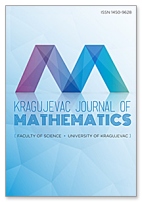A Categorical Connection Between Categories $(m, n)$-Hyperrings and $(m, n)$-Ring via the Fundamental Relation $\Gamma^\ast$
 Download PDF
Download PDF
Authors: A. ASADI, R. AMERI AND M. NOROUZI
DOI: 10.46793/KgJMat2103.361A
Abstract:
Let R be an (m,n)-hyperring. The Γ∗-relation on R in the sense of Mirvakili and Davvaz [?] is the smallest strong compatible relation such that the quotient R∕Γ∗ is an (m,n)-ring. We use Γ∗-relation to define a fundamental functor, F from the category of (m,n)-hyperrings to the category of (m,n)-rings. Also, the concept of a fundamental (m,n)-ring is introduced and it is shown that every (m,n)-ring is isomorphic to R∕Γ∗ for a nontrivial (m,n)-hyperring R. Moreover, the notions of partitionable and quotientable are introduced and their mutual relationship is investigated. A functor G from the category of classical (m,n)-rings to the category of (m,n)-hyperrings is defined and a natural transformation between the functors F and G is given.
Keywords:
(m,n)-rings, (m,n)-hyperrings, Γ∗-relation, category.
References:
[1] R. Ameri, A. Borzooei and M. Hamidi, On categorical connections of hyperrings and rings via the fundamental relation, Int. J. Algebraic Hyperstructures Appl. 1(1) (2014), 108–121.
[2] R. Ameri and M. Norouzi, Prime and primary hyperideals in Krasner (m,n)-hyperrings, European J. Combin. 34 (2013), 379–390.
[3] S. M. Anvariyeh and B. Davvaz, Strongly transitive geometric spaces associated to hypermodules, J. Algebra 322 (2009), 1340–1359.
[4] S. M. Anvariyeh, S. Mirvakili and B. Davvaz, ????-relation on hypermodules and fundamental modules over commutative fundamental rings, Comm. Algebra 36(2) (2008), 622–631.
[5] S. M. Anvariyeh, S. Mirvakili and B. Davvaz, Fundamental relation on (m,n)-hypermodules over (m,n)-hyperrings, Ars Combin. 94 (2010), 273–288.
[6] P. Corsini, Prolegomena of Hypergroup Theory, 2nd Ed. Aviani, Udine, 1993.
[7] P. Corsini and V. Leoreanu-Fotea, Applications of Hyperstructure Theory, Advances in Mathematics 5, Kluwer Academic Publishers, Dordrecht, 2003.
[8] A. Connes and C. Consani, The hyperring of Adele classes, J. Number Theory 131(2) (2011), 159–194.
[9] G. Crombez, On (m,n)-rings, Abh. Akad. Wiss. Hamburg 37 (1972), 180–199.
[10] G. Crombez and J. Timm, On (m,n)-quotient rings, Abh. Akad. Wiss. Hamburg 37 (1972), 200–203.
[11] B. Davvaz, Approximations in n-ary algebraic systems, Soft Comput. 12 (2008), 409–418.
[12] B. Davvaz, W. A. Dudek and S. Mirvakili, Neutral elements, fundamental relations and n-ary hypersemigroups, Internat. J. Algebra Comput. 19 (2009), 567–583.
[13] B. Davvaz, P. Ghiasvand and S. Mirvakili, Boolean rings obtained from hyperrings with η1,m∗-relations, Iran. J. Sci. Technol. Trans. A Sci. (to appear).
[14] B. Davvaz and V. Leoreanu-Fotea, Hyperring Theory and Applications, International Academic Press, Palm Harbor, Fla, USA, 2007.
[15] B. Davvaz and T. Vougiouklis, Commutative rings obtained from hyperrings (Hv-rings) with α∗-relation, Comm. Algebra 35(11) (2007), 3307–3320.
[16] B. Davvaz and T. Vougiouklis, n-ary hypergroups, Iran. J. Sci. Technol. Trans. A Sci. 30(A2) (2006), 165–174.
[17] M. De Salvo, Hyperrings and hyperfields, Annales Scientifiques de l’Universite de Clermont-Ferrand II 22 (1984), 89–107.
[18] W. A. Dudek, On n-ary group with only one skew element, Radovi Matematicki (Sarajevo) 6 (1990), 171–175.
[19] W. A. Dudek, Unipotent n-ary groups, Demonstr. Math. 24 (1991), 75–81.
[20] W. A. Dudek, Varieties of polyadic groups, Filomat 9 (1995), 657–674.
[21] W. A. Dudek, On distributive n-ary groups, Quasigroups Related Systems 2 (1995), 132–151.
[22] W. Dörnte, Untersuchungen über einen verallgemeinerten Gruppenbegriff, Mathematische Zeitschrift 29 (1928), 1–19.
[23] D. Freni, A new characterization of the derived hypergroup via strongly regular equivalences, Comm. Algebra 30(8) (2002), 3977–3989.
[24] E. Kasner, An extension of the group concept, Bull. Amer. Math. Soc. 10 (1904), 290–291.
[25] M. Koskas, Groupoids, demi-hypergroupes et hypergroupes, J. Math. Pures Appl. 49(9) (1970), 155–192.
[26] M. Krasner, A class of hyperrings and hyperfields, Int. J. Math. Math. Sci. 6(2) (1983), 307–311.
[27] V. Leoreanu-Fotea, Canonical n-ary hypergroups, Ital. J. Pure Appl. Math. 24 (2008), 247–257.
[28] V. Leoreanu-Fotea, B. Davvaz, Roughness in n-ary hypergroups, Inform. Sci. 178 (2008), 4114–4124.
[29] V. Leoreanu-Fotea and B. Davvaz, n-Hypergroups and binary relations, European J. Combin. 29 (2008), 1027–1218.
[30] F. Marty, Sur une Generalization de la Notion de Groupe, Huitieme congres des Mathematiciens Scandinaves, Stockholm, 1934, 45–49.
[31] Ch. G. Massouros, Theory of hyperrings and hyperfields, Algebra Logic 24(6) (1985), 477–485.
[32] S. Mirvakili, M. Farshi and B. Davvaz, On wearth product of n-polygroups, J. Algebra Appl. 14(4) (2015), DOI 10.1142/S02194988115500607.
[33] S. Mirvakili and B. Davvaz, Relations on Krasner (m,n)-hyperrings, European J. Combin. 31 (2010), 790–802.
[34] S. Mirvakili and B. Davvaz, Constructions of (m,n)-hyperrings, Mat. vesnik 67(1) (2015), 1–16.
[35] C. Pelea and I. Purdea, Multialgebras, universal algebras and identities, J. Aust. Math. Soc. 81 (2006), 121–139.
[36] E. L. Post, Polyadic groups, Trans. Amer. Math. Soc. 48 (1940), 208–350.
[37] R. Rota, Strongly distributive multiplicative hyperrings, J. Geom. 39(1-2) (1990), 130–138.
[38] S. A. Rusakov, Some Applications of n-ary Group Theory, Belaruskaya Navuka, Minsk, 1998.
[39] S. Spartalis, A class of hyperrings, Riv. Mat. Pura Appl. 4 (1989), 55–64.
[40] M. Stefanescu, Constructions of hyperfields and hyperrings, Studii si Cercetari Stiintifice. Seria: Matematica (16) (2006), 563–571.
[41] T. Vougiouklis, Hypergroups, hyperrings. Fundamental relations and representations, Quaderni del Seminario di Geometria Combinatoria (1989), 1–20.
[42] T. Vougiouklis, The Fundamental Relation in Hyperrings. The General Hyperfield, Algebraic Hyperstructures and Applications (Xanthi, 1990), 203–211, World Sci. Publishing, Teaneck, New Jersey, 1991.
[43] T. Vougiouklis, Hyperstructures and their Representations, Hardonic, Palm Harbor, 1994.
